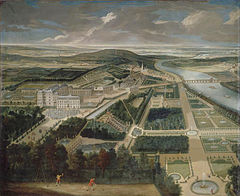Château de Saint Cloud
| Château of Saint-Cloud | |
|---|---|

The château and gardens, c. 1720
|
|
|
Location just west of Paris
|
|
| General information | |
| Type | Palace |
| Architectural style | French Baroque, Neo-Classical |
| Construction started | c.1570 |
| Completed | c.1701 |
| Demolished | 1891 |
| Client | Philippe of France; Marie Antoinette |
| Design and construction | |
| Architect | Antoine Le Pautre; Jean Girard; Jules Hardouin Mansart; Richard Mique |
The Château de Saint-Cloud was a palace in France, built on a site overlooking the Seine at Saint-Cloud in Hauts-de-Seine, about 5 kilometres west of Paris. On the site of the former palace there is currently a large park, the Parc de Saint-Cloud, that is owned by the state.
The château was expanded by Phillipe of France, Duke of Orléans in the 17th century, and finally enlarged by Marie Antoinette in the 1780s. After occupation by Napoleon I and Napoleon III, the château was destroyed in 1870 during the Franco-Prussian War.
The Hôtel d'Aulnay on the site was expanded into a château in the 16th century by the Gondi banking family. The Gondi stemmed from a family of Florentine bankers established at Lyon in the first years of the sixteenth century, who had arrived at the court of France in 1543 in the train of Catherine de' Medici. During the 1570s, the Queen offered Jérôme de Gondi a dwelling at Saint-Cloud, the Hôtel d'Aulnay, which became the nucleus of the château with a right-angled wing that looked out on a terrace.
The main front faced south, with a wing that terminated in a pavilion affording a handsome view over the Seine river. Henry III of France installed himself in this house in order to conduct the siege of Paris during the Wars of Religion, and here he was assassinated by the monk Jacques Clément.
After the death of Jérôme de Gondi in 1604, the château was sold in 1618 by his son Jean-Baptiste II de Gondi to Jean de Bueil, comte de Sancerre, who died shortly afterwards. The château was bought back by Jean-François de Gondi, archbishop of Paris. His embellishment notably included gardens by Thomas Francine.
...
Wikipedia

